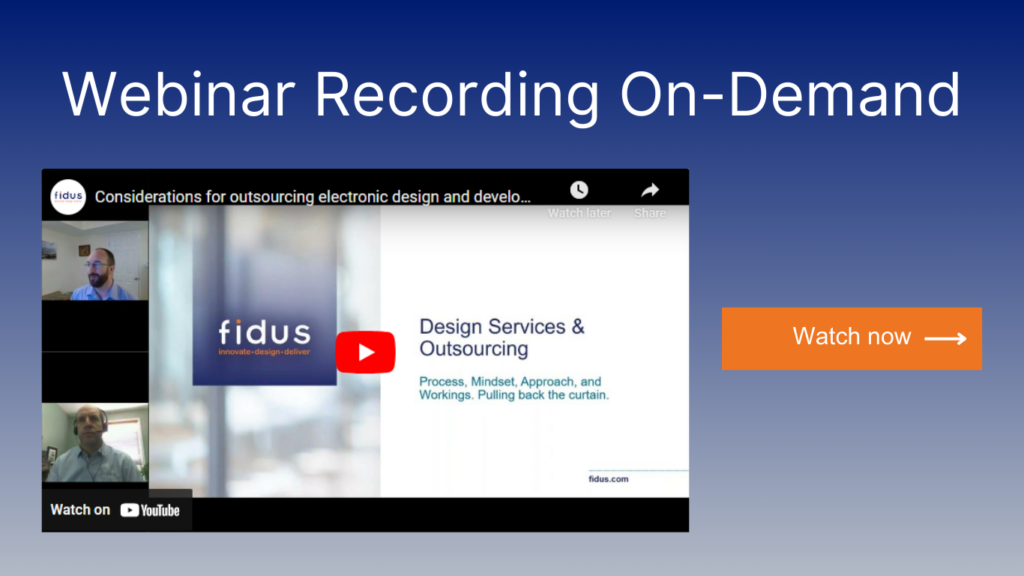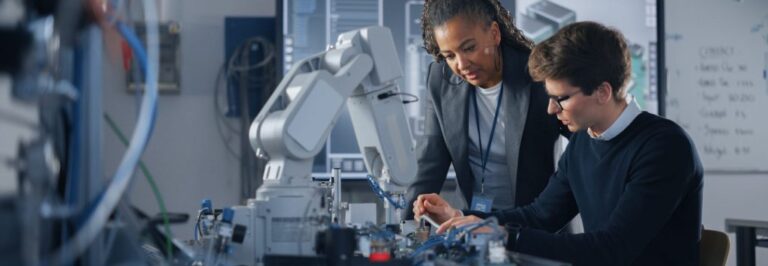In the rapidly advancing domain of electronic design, the strategic approach of outsourcing has become a cornerstone for companies seeking to innovate and remain competitive. This blog delves into the essential aspects of outsourcing electronic design services (EDS), focusing on FPGA design services, hardware development, embedded software development, and more. With insights from Fidus Systems’ webinar, led by Scott Turnbull, Chief Technology Officer (CTO) we explore the intricacies of selecting and collaborating with an EDS partner.
Here, engineers and decision-makers will learn not only how to choose the right outsourcing partner for custom engineering solutions, high-complexity electronic design, and other specialized services but also how to foster a successful, long-term partnership that brings their high-complexity electronic designs to life.
The Strategic Value of Outsourcing in Electronic Design
In an era where technology evolves at lightning speed, the agility to adapt and innovate is crucial for any business’s success. Outsourcing electronic design services is not merely a cost-saving measure; it represents a strategic move towards leveraging global expertise, accelerating product development cycles, and ensuring products meet the highest standards of quality and innovation. Scott Turnbull emphasizes the significance of viewing outsourcing partners not just as vendors, but as integral partners committed to the mutual success of your projects.
Why outsource custom electronic design services?
- Access to Specialized Expertise: Specialized expertise is crucial for advanced projects, and outsourcing partners offer a wealth of knowledge. Fidus stands out by providing access to an elite pool of experts in FPGA design, high-speed electronic design, and embedded software development. With a commitment to staying at the cutting edge, Fidus ensures that their team’s deep expertise and state-of-the-art methodologies are embedded into every project, making complex designs not just achievable but exceptional. This expertise is invaluable for projects requiring high levels of technical proficiency and innovation.
- Flexibility and Scalability: Custom electronic design services offer the flexibility to scale your project team according to current needs, ensuring that resources are efficiently allocated throughout the development cycle.
- Accelerated Time-to-Market: Experienced EDS partners inject valuable expertise and established design processes into your project, streamlining development workflows and reducing delays to propel your product to market faster.
- Cost and Time Efficiency: By outsourcing R&D and design tasks, companies can significantly reduce development time and associated costs, allowing for a more effective allocation of internal resources towards core business activities. EDS providers often have streamlined design processes, leading to faster project completion and reduced development costs.
- Exposure to Innovation: Leading EDS providers stay at the forefront of technological advancements, giving you access to cutting-edge design methodologies and the latest hardware and software tools. This can significantly improve your product designs and enhance their competitiveness.
Selecting the Right Outsourcing Partner
Choosing an outsourcing partner is a decision that goes beyond comparing cost quotes. It involves a comprehensive evaluation of the partner’s capabilities, cultural fit, and their ability to align with your project’s specific needs. Fidus distinguishes itself with a rich portfolio demonstrating capability in specific design areas such as high-speed PCB design and hardware expertise, supported by a robust team composition that ensures the necessary qualifications and experience to meet your design requirements.
Here are key factors to consider:
Technical Expertise and Experience
- Project Portfolio: Evaluate the partner’s proven track record in handling projects similar to yours. Look for a strong portfolio demonstrating their capabilities in specific design areas critical to your project. For instance, For instance, consider the side breadth of Fidus’ disciplines including high-speed PCB design, FPGA design, embedded software, mechanical and thermal design and signal & power integrity.
- Team Composition: Inquire about the team composition assigned to your project. Ensure they possess the necessary qualifications and relevant experience to meet your design requirements.
- References: Request references from previous clients in your industry to gain valuable insights into the partner’s work ethic, communication style, and ability to deliver projects on time and within budget.
Communication and Collaboration:
- Communication Style: Ensure the EDS provider prioritizes clear and transparent communication. Evaluate their preferred communication methods (email, video conferencing, project management tools) and response times to ensure they align with your expectations.
- Collaboration Approach: A successful partnership thrives on collaborative problem-solving and open communication. Assess the partner’s willingness to actively solicit your feedback and work closely with your in-house team throughout the design process. Fidus, for example, emphasizes a collaborative environment, keeping clients informed through regular updates and interim project deliverables.
- Cultural Alignment: Consider the partner’s company culture and how it aligns with your own. A shared work ethic and collaborative spirit can foster a more productive and mutually beneficial relationship.
Security and Confidentiality:
- Data Security Measures: Your intellectual property must be protected. Select a partner with robust data security measures in place, including encryption protocols, access controls, and regular security audits.
- Non-Disclosure Agreements (NDAs): Ensure both parties have signed confidentiality agreements (NDAs) to safeguard sensitive project information and intellectual property.
Cost Structure and Value Proposition:
- Pricing Models: EDS providers typically offer various pricing models, such as fixed price, time and materials (T&M), or cost-plus. Evaluate pricing structures in detail and ensure they align with your project budget and risk tolerance.
- Value Proposition: Beyond cost, consider the overall value proposition offered by the partner. This includes their expertise, efficiency, proven track record, and potential return on investment (ROI).
Scalability and Flexibility:
- Resource Pool: Choose an EDS provider with the ability to scale their resources to accommodate your project’s fluctuating demands. Inquire about their internal talent pool and ability to quickly ramp up or down the design team size as needed.
- Scalable Infrastructure: Ensure the partner has the infrastructure and design tools necessary to handle projects of varying complexity. This infrastructure should be scalable to accommodate increased processing power or specialized software requirements as your project progresses.
Quality and Reliability:
Assess the outsourcing partner’s commitment to quality and reliability. This can be gauged through their quality control processes, certifications (e.g., ISO 9001), and their approach to project documentation and handover.
Innovation and Future Proofing:
The ideal partner not only addresses current project needs but also anticipates future technology trends. Their ability to offer innovative solutions and advice on future-proofing your product can be a significant asset.
Effective Collaboration for Project Success
A successful outsourcing partnership is characterized by a collaborative approach, where both parties work towards a common goal.
Here are some best practices to cultivate a successful collaboration:
- Define Project Needs and Culture: Develop a comprehensive Project Definition Document (PDD) in collaboration with your partner. This document should clearly outline your project objectives, performance expectations, deliverables, and timelines. A well-defined scope of work prevents misunderstandings, ensures alignment with your vision, and serves as a reference point throughout the design process.
- Establish Success Criteria: Establish clear and measurable success criteria to evaluate project progress and ensure the final product meets your expectations. These criteria may include performance benchmarks, functional specifications, or manufacturing readiness requirements. Working with partners to define these criteria upfront fosters a shared understanding of the project’s goals and facilitates smoother progress.
- Assess Pre-Sales Considerations: The importance of transparent communication from the outset cannot be overstated. Setting realistic expectations and having a mutual understanding of project scope and objectives ensures both parties are aligned, a theme Scott revisited multiple times.
- Navigate Project Execution Stages: Effective project execution is a ballet of coordination, requiring careful selection of the project team, clear kickoff directives, and strategies for maintaining client involvement. Scott shared strategies for navigating these stages, emphasizing the importance of a partnership approach rather than a transactional relationship.
- Manage Projects Effectively: Project management is an art that balances resources, timelines, and project milestones. Scott’s insights into monitoring project progress, managing resources efficiently, and ensuring timely completion within budget constraints are golden rules for success.
- Ensure Smooth Design Handover and Knowledge Transfer: A successful project doesn’t end at delivery; it requires a smooth handover and effective knowledge transfer. This ensures the client’s team can manage, maintain, and further develop the project outcomes, emphasizing the project’s long-term success.
- Building a Long-Term Partnership: The culmination of successful project execution is the establishment of a long-term partnership. This relationship is predicated on trust, mutual success, and the continuous pursuit of innovation, ensuring sustained growth and competitiveness in the market.
Next Steps: Leverage Outsourcing for Your Electronic Design Needs
As you contemplate outsourcing your electronic design needs, consider how a partnership with a company like Fidus can transform your approach to product development. With their comprehensive range of services, from FPGA design to embedded software development, Fidus is equipped to handle the complexities of modern electronic design projects.
In conclusion, the strategic outsourcing of electronic design services offers a pathway to innovation, efficiency, and competitive advantage. Choosing Fidus as your outsourcing partner means engaging with a company that brings more than just technical expertise to the table; it means benefiting from their holistic approach to project management, from initial concept through to post-deployment support. Fidus’ commitment to quality, reliability, and cutting-edge technology ensures that your projects are not only completed to the highest standards but are positioned at the forefront of industry advancements.
By carefully selecting the right partner and fostering a collaborative relationship, companies can navigate the complexities of modern electronic design, ensuring their products not only meet but exceed market expectations.
Ready to unlock the full potential of outsourcing electronic design services? Watch the on-demand webinar with Scott Turnbull for expert insights.
Watch now





